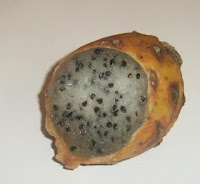Along with all the more common fruits you are used to plus papaya, kiwi, melons, and passion fruit, the markets in Ecuador are filled with exotic fruits you may never have seen before. After opening, deseeding and sometimes skinning, most can be made into exceptional fresh juices (jugos) using a blender, juicer or citrus juicer.
Mora (Blackberry) Ecuadorian blackberries are different from those you’re used to as they are larger and more tart. The blackberry bushes grow like weeds in most parts of the country. Although they can be eaten right off the vine, generally Ecuadorians blend them with water and add a little sugar for an excellent juice.
Tomate (Tree Tomato) The tree tomato is a red, egg-shaped fruit full of pulp-covered seeds
somewhat like passion fruit. They are called tomatoes because their reddish color is a like a tomato and the juice made from the seeds tastes vaguely like a tomato. Tree tomatoes are good for juice or for boiling in sugar for a dessert treat but they are too sour to eat fresh.
Taxo (Banana Passionfruit) is an elongated, soft fruit that looks a little like a small, straight, orange banana. Inside of the fruit, there are dozens of seeds covered in pulp which you remove from the seeds. The pulp is used to make juice or ice cream. The skin is discarded. Taxos have a tangy, tart taste, and although they can be eaten fresh, they rarely are. In shops, where they make handmade ice cream, the taxo is a popular flavor.
Guanábana (Soursop) The Guanábana is a green fruit with a rough outer skin. They can get quite large, some reaching the size of a soccer ball. Inside the green skin, the fruit is white and pulpy and full of many seeds, each of which is about the size of a cherry. This white flesh can be eaten fresh and tastes vaguely of strawberry. It is very sweet and mild. Because it is messy to eat and the seeds are annoying, Ecuadorians prefer to make juice out of them.
Naranjilla (Little Orange) are a round, bright orange fruit a little smaller than a tennis ball. The inside is full of tiny seeds and pulp. The pulp is scooped out and blended, strained and sweetened to make a greenish-orange, tangy juice that has an interesting perfume-like aftertaste. The naranjilla is native to Ecuador and Colombia and rarely grown elsewhere.
Granadilla (Sweet Granadilla): Referred to as passion fruit in some parts of the world, granadillas are small, pale orange-pink, egg-shaped fruit. The outer shell of the fruit cracks open to expose the fruit inside which consists of dozens of black seeds enclosed in a semi-transparent gray pulp. The seeds and pulp are eaten whole and the cracked skin is discarded. Granadillas have a very mild, fruity flavor. They are generally eaten fresh and raw as they are far too mild for juice.
Pitahaya (Dragon Fruit): Ecuadorian pitahayas are bumpy yellow fruit that grow on a local species of tree cactus. The skin is cut open to reveal the pulp which is semi-transparent, grayish and full of tiny black seeds. Eating one is a little like eating a kiwi. The fruit is sweet and mild and is usually eaten raw and fresh although it also makes good juice. It has mild laxative properties.
Uvilla (Ground Cherry, Gooseberry): These small yellow fruits are called ground cherries because they grow close to the ground and are roughly cherry-like in size and shape. They have nothing in common with cherries, including taste and there is no stone. They are bright yellow and grow inside a husk that looks like a paper lantern. The flavor is a somewhat like pineapple and they are eaten raw and fresh, one after another, like popcorn.
Uvilla (Ground Cherry, Gooseberry): These small yellow fruits are called ground cherries because they grow close to the ground and are roughly cherry-like in size and shape. They have nothing in common with cherries, including taste and there is no stone. They are bright yellow and grow inside a husk that looks like a paper lantern. The flavor is a somewhat like pineapple and they are eaten raw and fresh, one after another, like popcorn.
Tuna (Prickly Pear): Not to be confused with the fish, the tuna is the fruit of a species of cactus. The fruit even looks like a small cactus. The outer green skin is cut open to reveal the red pulp inside. There are small, crunchy seeds that are tasteless and can be eaten. The fruit itself has a very mild flavor and is fairly bland.
Orito (Finger Banana): Ecuador is famed for the varieties of bananas it produces. One favorite is the Orito,a small banana, about half the size of the ones destined for export. Oritos are sweeter and have a slightly richer taste than the bananas sent abroad.
If you prefer you can buy many of the above as fresh, squeezed pulp in plastic bags at almost any market.
Oranges: Throughout the world there are 97 varieties of oranges. In Ecuador a few of these varieties are grown everywhere and make wonderful fresh juice. The large oranges have no seeds but are less sweet. The small oranges are full of seeds but are very sweet. We mix them together to make our morning orange juice.
It takes a little experimenting to know the right amount of sweetener to add to the pulp of the more exotic fruits to create a juice that you will enjoy. But after trying them one by one they open up a whole new source of pleasure and good nutrition. +Bill+and+Loretta.bmp)










+bagged+juice.bmp)

No comments:
Post a Comment
Please leave a comment.